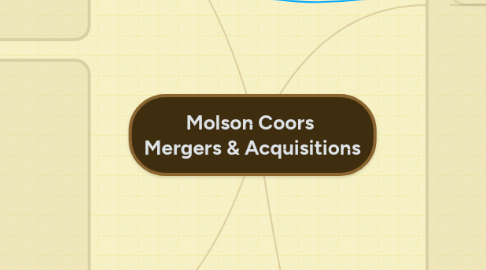
1. Molson Coors History
1.1. Molson founded 1786
1.2. Company branches out and invests in areas outside brewing
1.2.1. 1807: Steamboat
1.2.2. 1825-1826: Hotel & Theatre
1.2.3. Montreal's first public hospital
1.2.4. 1995: Molson Ampitheatre
1.3. 2005: Major merger with Coors, creating Molson Coors
2. Creemore Springs
2.1. Acquired by Molson Coors in 2005 for US$17 Million
2.1.1. Small North American brewery
2.2. Molson Coors immediately invested US$20 Million in Creemore Springs
2.2.1. Increased distribution capabilities
2.2.2. Creemore Springs remained profitable
2.3. Success based on changes from previous acquisition
2.3.1. Responsible Financial Decisions
2.3.1.1. Paid a fair amount for Creemore Springs
2.3.1.2. Made an informed decision to invest in new business
2.3.2. Attention to Cultural Differences
2.3.2.1. Large company vs small company
2.3.2.1.1. Recognized different management styles
2.3.2.1.2. Recognized Creemore Springs' product & market knowledge
2.3.3. Well Researched Strategy
2.3.3.1. Aligned with cultural and financial needs
2.3.3.2. Afforded Creemore Springs independence to make the best decisions
2.3.3.2.1. Knew what customers wanted
2.3.3.2.2. Knew how to maintain positive brand image within its niche market
2.3.3.3. Investment allowed Creemore Springs to become more profitable
2.3.3.3.1. Financial decision was well-informed
3. Kaiser
3.1. Acquired by Molson in 2002 for US$765 Million
3.1.1. 2nd largest brewery in Brazil
3.2. Costing Molson US$100 Million per year to keep Kaiser running
3.2.1. After 4 years, Kaiser worth only US$68 Million
3.2.2. Molson lost 50% of the market share Kaiser previously had
3.3. Various issues caused failure
3.3.1. Poor Financial Planning
3.3.1.1. Overpaid for Kaiser, massive costs to keep it running
3.3.1.2. Company value plummeted due to poor management
3.3.2. Poor Marketing
3.3.2.1. Attempted to break into premium beer market
3.3.2.1.1. Ad campaign failed
3.3.2.1.2. Market did not desire product
3.3.3. Failure to Comprehend Cultural Differences
3.3.3.1. No cultural assessment done to recognize differences
3.3.3.1.1. Unable to make culturally informed decisions
3.3.3.2. North America vs South America
3.3.3.2.1. Different management styles
3.3.3.2.2. Different bureaucratic issues
3.3.3.2.3. Different business environment
3.3.3.3. Chaotic transition period
3.3.3.3.1. Replaced South American management with North American management
3.3.3.3.2. Disregard for benefits of subsidiary's management practices
3.3.4. Misaligned Strategy
3.3.4.1. Desire to expand into new markets vs Financial stability and actual growth
3.3.4.1.1. Company goals did not match financial or cultural realities
3.3.4.1.2. Lack of cultural assessment failed to recognize strategic problems
3.3.4.1.3. Poorly researched initial investment
3.3.4.2. Molson Coors micromanagement of Kaiser caused cultural issues
3.3.4.2.1. Insisted on using North American management in Brazilian environment
3.3.4.2.2. Kaiser afforded very little independence
4. Recommendations
4.1. Attention to Cultural Issues
4.1.1. Cultural assessment a key to success
4.1.1.1. HR's due diligence during this phase ensures that strategy aligns with cultural realities within companies (Parent/Subsidiary, mergers)
4.1.1.2. "Seeing eye-to-eye" important for companies to come together with positive results
4.2. Align Strategy & Finances
4.2.1. Strategic goals should be tempered by financial realities
4.2.1.1. Kaiser: desire to expand overrode financial importance
4.2.1.2. Creemore Springs: expansion created profitable growth
4.2.1.3. Financial success dependent on understanding cultural differences and using them to inform strategic and financial decision making

